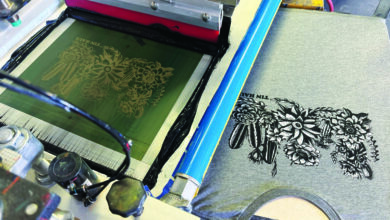
“Good evening folks, welcome to Café Charboneau. I see you’ve had a chance to look at the menu. Do you know what you would like to start out with?”
“Well, not really. We’re not sure what we’re hungry for. Can you just have the cook whip up something that we’ll like? You serve food to customers all day every day, so your Chef should have some good ideas for what we will probably like.”
Every once in a while, sign salespeople run into a customer like this. It’s frustrating, and it’s a nightmare for the person doing the designing. They hear from customers excuses like this:
- “We’re not exactly sure we know what we want, but we will know it when we see it.”
- “Just come up with a few ideas – something your designer likes, and we can go from there.”
- “I was hoping that your designer could simply whip up a design that I will like.”
You’re the designer on this project … lucky you!
It’s yet another opportunity to put on the blindfold and pull another awesome, dynamic, creative rabbit out of your hat. (Oh yeah, it’s also got to fit within their budget, which is also a mystery.) “Be the Hero, not the Zero” is all you keep hearing in the back of your head as you read the words written out on the design request form: “Customer has no idea what they want for their monument sign; just come up with something cool,” they said.
I’ve heard it stated a hundred different ways and it makes my skin crawl every time a directive like this is conveyed by the customer. Salespeople sometimes don’t stand a chance when a customer just won’t or can’t convey their hopes and desires for their sign. Some customers are simply unable to express themselves in this way, others play the “closed-lip” game in order to maintain some sort of obscure control of the process. Regardless of the real underlying reasons, if you must come up with a design, you’ll have to learn how to read the customers mind, and just how do you do that?
When your instructions are non-existent, and you have two days to create a design presentation, what do you do and how do you proceed? Where do you start when you know so little about what the customer really wants?
When I am faced with this design challenge, I use a process that has worked well for me time and time again, and this is that process.
Step one, take charge of the process
You’ve been handed a task that you really didn’t want. It’s not impossible to “guess” at a design and create one that the customer likes, it just contains a lot of wasted mental gymnastics. So, take charge of the process (or ask your salesperson to) so that you are able to guide the customer into making a decision; a good decision on a sign design that will fulfill their needs.
Start with basic sketches-garner their involvement in the designing process
Customers should be walked through the process so they have a say in the whats and whys of the designs presented. Remember, at this point they still don’t have a clue as to what they want. What you are doing is introducing the customer to “The Design Process” and you are going to do it one tiny little minor decision at a time.
Presentation is key-enlighten them with the facts
If possible, ask your salesperson (or your survey tech) to take some photos of the customer’s competition’s signs. No matter what type of sign it is, if they have a local competitor grab a photo of that sign with the absolute best resolution and composition you can muster. If no competition, take photos of other signs that might be similar to something that will meet your client’s needs. Make the photos look really good!
Put these photos all together on a presentation page. Label each photo and indicate approximate size for each sign. This sets the stage for getting the customer to pay attention to what’s at stake. Yes, this is a big deal. This is much more than a sign, it’s their company shield, their image within the community, their identity. This step kind of forces them to start thinking about that which they said they could not visualize.
Next, do your research on the company
It’s colors, logos, applications of those logos, other existing signage, advertising, their website, building architecture, etc. By incorporating some of these elements into the design you increase your chances of impressing the customer.
At this point you have already created three or four concepts or ideas to show them. If you want this process to work properly, you must develop a plan on how to present the concepts so that the customer follows you like the caboose to your train of thought.
Start out by showing them the concepts and explain briefly how you came up with each idea, and why the shapes you chose will help the sign satisfy their needs for the new sign. Be clear as to why you chose your design features and have the answers prepared as to why you and your salesperson think the designs hold their own merit.
If they mention budget, be prepared to explain how value engineering can sometimes make it possible to stay within budget. Make sure you keep pushing for the end result: design approval.
After they discuss with you their likes and dislikes they may or may not settle on a design shape. They may find favor with your concepts as a whole, but not any one design inspired them. At this point, you may think, “Oh well, back to the drawing board.” And that is where some designers and salespeople make a big mistake. Simply going back and trying some more ideas can be a big waste of time. You must find out from the customer what it is that they don’t like about the designs. More importantly, you must find out what it is about each design they like.
Once you can get them to tell you what they do like about all three designs, you can then create a new design that contains all of those elements they said they like. Be sure to also include two more slightly different options that you will only show if they don’t like the main design. We don’t want to confuse the matter, but being prepared with two more concepts will come in handy if you have missed the mark and they don’t like the hybrid-combination sign you created. It will keep the process rolling.
I have watched customers go from being completely clueless as to what they want or needed to being excited about their new design. Do a favor for your customer, your salesperson and yourself and practice your skills for guiding the customer into making the decision that’s best for them, and their family.



